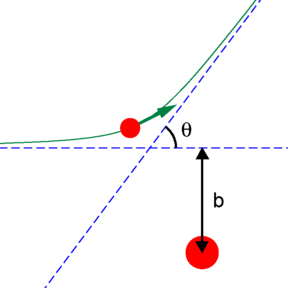
Impact parameter
Encyclopedia

 is defined as the perpendicular distance between the path of a projectile and the center of the field
is defined as the perpendicular distance between the path of a projectile and the center of the field  created by an object that the projectile is approaching (see diagram). It is often referred to in Nuclear Physics
created by an object that the projectile is approaching (see diagram). It is often referred to in Nuclear PhysicsNuclear physics
Nuclear physics is the field of physics that studies the building blocks and interactions of atomic nuclei. The most commonly known applications of nuclear physics are nuclear power generation and nuclear weapons technology, but the research has provided application in many fields, including those...
(see Rutherford Scattering
Rutherford scattering
In physics, Rutherford scattering is a phenomenon that was explained by Ernest Rutherford in 1911, and led to the development of the Rutherford model of the atom, and eventually to the Bohr model. It is now exploited by the materials analytical technique Rutherford backscattering...
), as well as in Classical Mechanics
Classical mechanics
In physics, classical mechanics is one of the two major sub-fields of mechanics, which is concerned with the set of physical laws describing the motion of bodies under the action of a system of forces...
.
The impact parameter is related to the scattering angle
 by
by
where
 is the velocity of the projectile when it is far from the center, and
is the velocity of the projectile when it is far from the center, and  is its closest distance from the center.
is its closest distance from the center.

